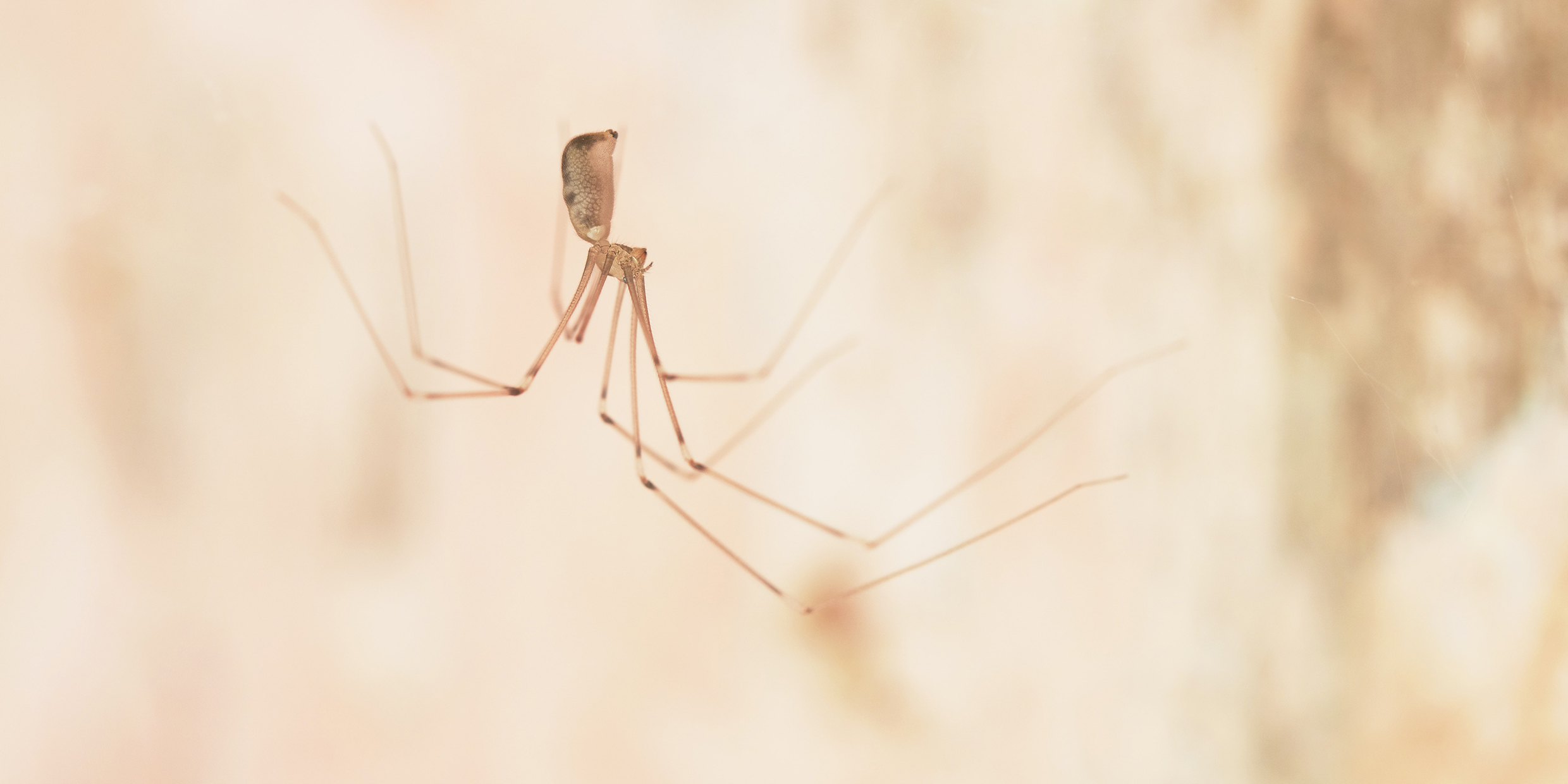Originally published 31 August 1998
For a few months each summer, I live in a cottage in the west of Ireland that is unoccupied for the remainder of the year. When we arrive in June, every nook and cranny is occupied by one or more common cellar spiders, Pholcus phalangioides, sometimes called “daddy-long-legs.”
My wife’s first impulse is to take a broom and go squishing and swishing her way through the house. My own instinct is to let the spiders be: They are harmless, virtually invisible, and — with the aid of a magnifying glass — delightful to observe.
When my wife’s killing sweep is done, despite her best efforts, there are still dozens of spiders in corners beyond her reach or on the porch or in the store room. Enough spiders for a happy summer of spider-watching.
I have been watching a Pholcus suspended in a tangle of threads from the underside of the shelf above my desk. The head is about the size of a pinhead, the bulbous, cylindrical abdomen somewhat larger. Mostly the spider is all legs — eight long, crooked, translucent legs, black at the joints.
All morning long the spider has sat unmoving in its web, suspended upside down; one might think it is dead. However, if I touch the web with a pencil point, the spider goes into a crazy dance, whirling furiously. Several times I test this reflex, wondering what is its purpose. To more thoroughly ensnare a prey? To frighten predators? To make itself an invisible blur? The dance is instinctive. It is not something the spider learns. It is an evolved reflex, encoded in the spider’s DNA — a whirling dervish gene.
This normally sedentary creature sits and waits for its food to come to it. Insects that bumble into the web are quickly wrapped with silk. The spider injects a digesting fluid into the prey’s body, then sucks out the liquidy innards. I read somewhere that a Pholcus spider can empty a fly by sucking at the tip of a leg!
Of course, like all animals, the spider must make more of its own kind. The sexually mature male must find and court a female, presumably no small thing for the individual I am watching, since the nearest other Pholcus, that I can see, of uncertain sex, is suspended in a corner of the ceiling 10 feet away.
Mating can take hours: a terrible tangle of legs. The male deposits a wispy wallet of semen into a special cavity in the outer uterus of the female, where the sperm resides until she uses it to fertilize her eggs. The female lays 20 or so eggs, which she carries in her jaws in a silk cocoon.
Prenymphs hatch from the eggs. A week or so later these shed their skins and tiny baby spiders emerge. They might hold onto their mother’s face for a time, then scamper off to fend for themselves.
I have watched most acts of this curious drama, but one big mystery remains. According to my guidebook, this species of spider is unknown out-of-doors in Ireland, which raises the question of how it managed to colonize our house in the first place; the house was built new and far from any neighbor.
It is tempting to imagine countless young Pholcus aeronauts on silk parachutes floating out of windows, across fields and hedgerows, into other doors or windows. It is probably the rare Irish country house, no matter how immaculately maintained, that does not in some dusty corner harbor its Pholcus.
To deepen the mystery, this spider thrives on every continent except Antarctica — and perhaps there, too, for all I know — which means this leggy arachnid, for all of its sedentary ways, manages to get around with remarkable efficiency.
The spider’s far-flung flights are a kind of revelation, its web a gauzy scripture. Far from wasting time this morning, I know that my observations of the spider have taught me as much about myself as about Pholcus, for we are all part of the same web of life.
I would go as far as to say that my attentions to the spider are a kind of prayer. Ralph Waldo Emerson defined prayer this way: “Prayer is the contemplation of the facts of life from the highest point of view. It is the soliloquy of a beholding and jubilant soul.”
My beholdings of Pholcus are certainly jubilant: Canopies of silk, black knees, tangled legs, gossamer packets of sperm. Add to these the female with a face full of tiny offspring, and that unseen sequence of protein-building chemicals somewhere along the spider’s DNA that encodes the dervish dance.
This is Emerson’s prayer: To intrude ourselves into the fabric of the world; to quiet the insistent murmurings of self long enough to understand that we all exist in a greater matrix of life, and that all life exists in a yet greater matrix of matter and energy. The object of such a prayer need not be the star-spangled dome of heaven, or the majesty of waves crashing on a shore. It can be as subtle as a thread-legged spider in a gossamer nest.
God told Elijah to stand on the mountain: “Then Yahweh himself went by. There came a mighty wind so strong it tore the mountains and shattered the rocks before Yahweh. But Yahweh was not in the wind. After the wind came an earthquake. But Yahweh was not in the earthquake. After the earthquake came a fire. But Yahweh was not in the fire. And after the fire there came the sound of a gentle breeze. And when Elijah heard this, he covered his face with his cloak and went out and stood at the entrance of the cave.”
Elijah went to the entrance of his cave and attended the breeze. And on the breeze came a flotilla of baby spiders, riding in gondolas of silk.



